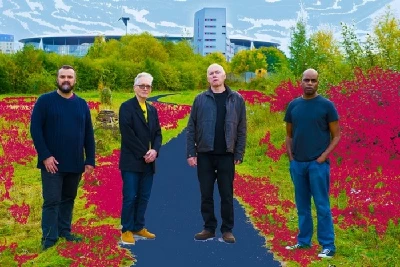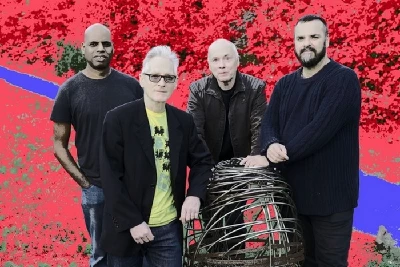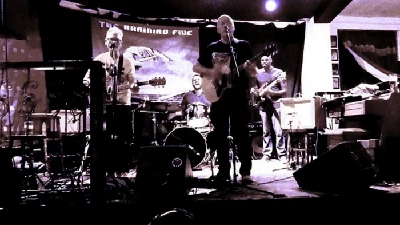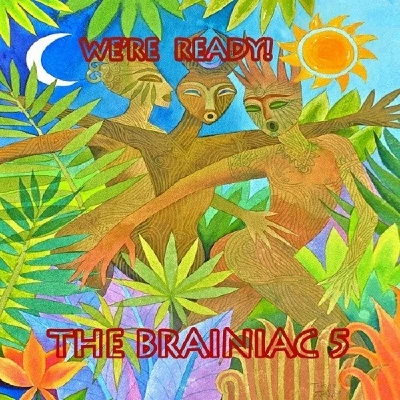published: 9 /
2 /
2018

Cornwall’s reunited the Brainiac 5 chat with Kimberly Bright about their early career, reunion, recent work, and John Peel
Article
Cornwall’s the Brainiac 5 – appropriately named after the 30th and 31st century DC Comics character from the Legion of Super-Heroes – have had a strange but admirable career path. Starting out in the pre-punk mid-‘70s as local favorites frequently found on major British festival bills, they developed a following in London in the latter part of the decade as punk and post-punk held sway, most notably with the release of their 1978 EP 'Mushy Doubt', which attracted the attention of legendary DJ John Peel. Despite such a promising early career and attention, the Brainiac 5 broke up in 1980 before their completed debut album 'World Within' could be released. The band members went their separate ways until 2013, with lead singer and guitarist Charlie Taylor relocating to the US for much of that time. When they finally reunited, it wasn’t because of a lucrative reunion package tour or documentary, crowd-funded album, or one-off nostalgic reunion show; it was simply because they wanted to play music together again. In a very short time they released a compilation of their ‘70s recordings ('When Silence Was Sound') and recorded 2014’s 'Space Is the Place' EP, 2015’s 'Exploding Universe', and two albums this year alone, 'Journey to X' and 'We’re Ready!'.
Charlie Taylor and bassist John “Woody” Wood recently spoke to Pennyblackmusic about the Brainiac 5’s stop and start but long-standing career, what happened to the band members in the interim, and their latest album 'We’re Ready!', with its enigmatic album artwork (courtesy of Woody).
PB: How did you all end up in Cornwall in the ‘70s at the same moment? Where were you from originally?
CT: I was born in Newcastle, a primitive part of the UK. My family were hunter-gatherers, foraging for food from our mud-hut home. I went to college in Oxford, where I was a member of proto-spacerock group, the Half Human Band. I fell in love with a Cornish girl and together we moved to Cornwall in 1975. At that time Cornwall was a kind of hippy Shangri La. It was cheap to live - no one had to work much. Everyone was painting or playing music and/or wandering around appreciating nature. I began to perform in the folk clubs with Bert Biscoe, a Cornish singer-songwriter. Later, we teamed up with Woody on bass and Steve Hudson on drums. Woody, being comparatively entrepreneurial, opened a club called Jacey’s, which quickly became the hip place to go in Penzance. We were the house band. The existence of the club encouraged the formation of numerous other bands. In Jacey’s we could play our own material. We earned money by playing cover versions at gigs for tourists during the holiday season.
PB: How would you describe the music scene in Cornwall and in London, then and now? What do you think of the now much larger (and expensive) festival circuit?
CT: The music scene in Cornwall in the late ‘70s was wide open. We were one of very few bands playing original material and we quickly built up a following. We recorded an LP with the help of Martin Griffin from Hawkwind and moved up to London seeking fame and fortune. Unfortunately we had to get real jobs to pay the rent there. In Cornwall we were used to rehearsing almost every day, and playing two or three gigs a week. In London we were rehearsing very little and playing once a month to small audiences. The music became stale. We broke up after about a year and went off in different directions.
The Cornish music scene is quiet these days. London is, of course, ridiculously active. We have a monthly residency at The Gunners in North London where we attract a loyal crowd. We can experiment with new tunes there.
The festival circuit: In the ‘70s we played at all the Cornish festivals. Since reforming we’ve played at a small number in various UK locations. It’s always fun, and the money tends to be good.
PB: Did you ever try to contact other dead rock stars via a Ouija board or only Hendrix?
CT: No rock stars, but we did make contact with the Roman philosopher Epictetus, who told us it was OK to be so poor that we had to live on rice and cabbage.
PB: What are your memories of John Peel?
CT: At the time his approach to being The Most Influential DJ In The World seemed perfectly normal, but in retrospect it’s astonishing. We called the BBC, asked to speak with him, were put through to him, told him we had a record we’d like him to hear, he invited us to the studio in Broadcasting House, where he was recording his show, he chatted with us then played the record. A very modest, unassuming and helpful chap.
PB: Did the others keep in touch while you lived in America? Why did you return to the UK?
CT: I returned to the UK once or twice a year and would occasionally see Brainaic 5 people, but I was in a religious cult at the time – we weren’t really supposed to spend time with non-members. I left the cult in 2008 and moved back to London in 2009, partly to look after my parents and partly because I missed going to the theatre.
PB: What were your bands, jobs, and other projects in the interim?
CT: I started Reckless Records, the shop, in London in 1984, then moved to San Francisco and opened one there. The San Francisco store is closed, but we now have three stores in Chicago. That keeps me busy. In the US I played in a band called Brian’s Head with other cult members.
PB: How did Sun Ra's music influence you musically, spiritually/philosophically, and as a catalyst to reunite?
CT: When I was a schoolboy I began to listen to the Beatles like everyone else, then the Kinks, the Yardbirds etc. I saw a very early performance of Cream before their first LP in a tiny club in Woking. I also saw Jimi Hendrix shortly after he arrived in the UK. These were formative experiences. John Peel started to play Captain Beefheart. I bought 'Trout Mask Replica' and after several months of hard listening finally understood it. It’s a wonderful experience when your conception of music is enlarged like that! Around the same time, for some odd reason our local record store acquired a copy of Sun Ra’s 'Heliocentric Worlds Vol. 2'. I listened to it in my school lunch break and couldn’t understand it at all, but sensed there was something important there and bought it anyway. After another long gestation period it finally clicked. After that I bought dozens of Ra records and saw him live many times. His influence on the Brainiacs is not that our music sounds like his, it’s more that we feel free to try any form of music whatsoever and mix it all up. Also, while much of our music is carefully written, we do leave space for free improvisation. And he shows it’s possible to combine serious music with a subtle sense of humour.
PB: What are some of the hidden meanings of the interior album artwork for 'We're Ready!', such as the game board and the crescent moon? What beer is featured?
JW: The inner sleeve references some of the track titles and lyrics.
The three pictures on the wall have the band giving a 'Wave', the guy with the guitar is Robbie Basho, referenced in 'Drinking Song' and the guy with the glasses is Trotsky.
The broken hearts in the wall paper reference the unrequited love in 'She's Free' (a.k.a Trotsky).
My watch looking indicates 'My Time', whilst the moon and shooting star just show that 'Space is the PLace', and it is time for some 'Night Games'. The board game is just one such game, with the pieces involved in that popular night pastime, sex! Maybe run a magnifying glass over them to more clearly see.
The drinking we are involved in is discussed in 'Drinking Song'. The brew we are imbibing is something of our own concoction called 'Space is the Place'. The label for this on the bottle is actually taken from the cover of our 10” vinyl of that name, painted by renowned psychedelic artist, John Hurford.
As three of the songs from 'We’re Ready!' are from the bands original incarnation we thought it would be appropriate to be wearing T-shirts depicting the covers of our releases from that period.
PB: Charlie, did you miss St. Austell beer while in the U.S.?
CT: I soon adapted to Bud Light, sorry to say.
PB What are your future plans?
CT: We’re in the middle of recording a 12” single called 'Back to Shore'. Both sides will be about ten minutes long with the same very repetitive backing track, creating a timeless effect. We’re inviting everyone we’ve ever played with to contribute vocal and/or instrumental overdubs. Side A is based around a long poem by our original vocalist Bert Biscoe, with vocal, flute, whistle and sax contributions from Chrissy Quayle (her story is here: http://kernowbeat.co.uk/daylight.html ).
PB: Thank you.
Band Links:-
https://twitter.com/thebrainiac5
https://brainiac5.bandcamp.com/
https://www.facebook.com/TheBrainiac5
Play in YouTube:-
Picture Gallery:-


